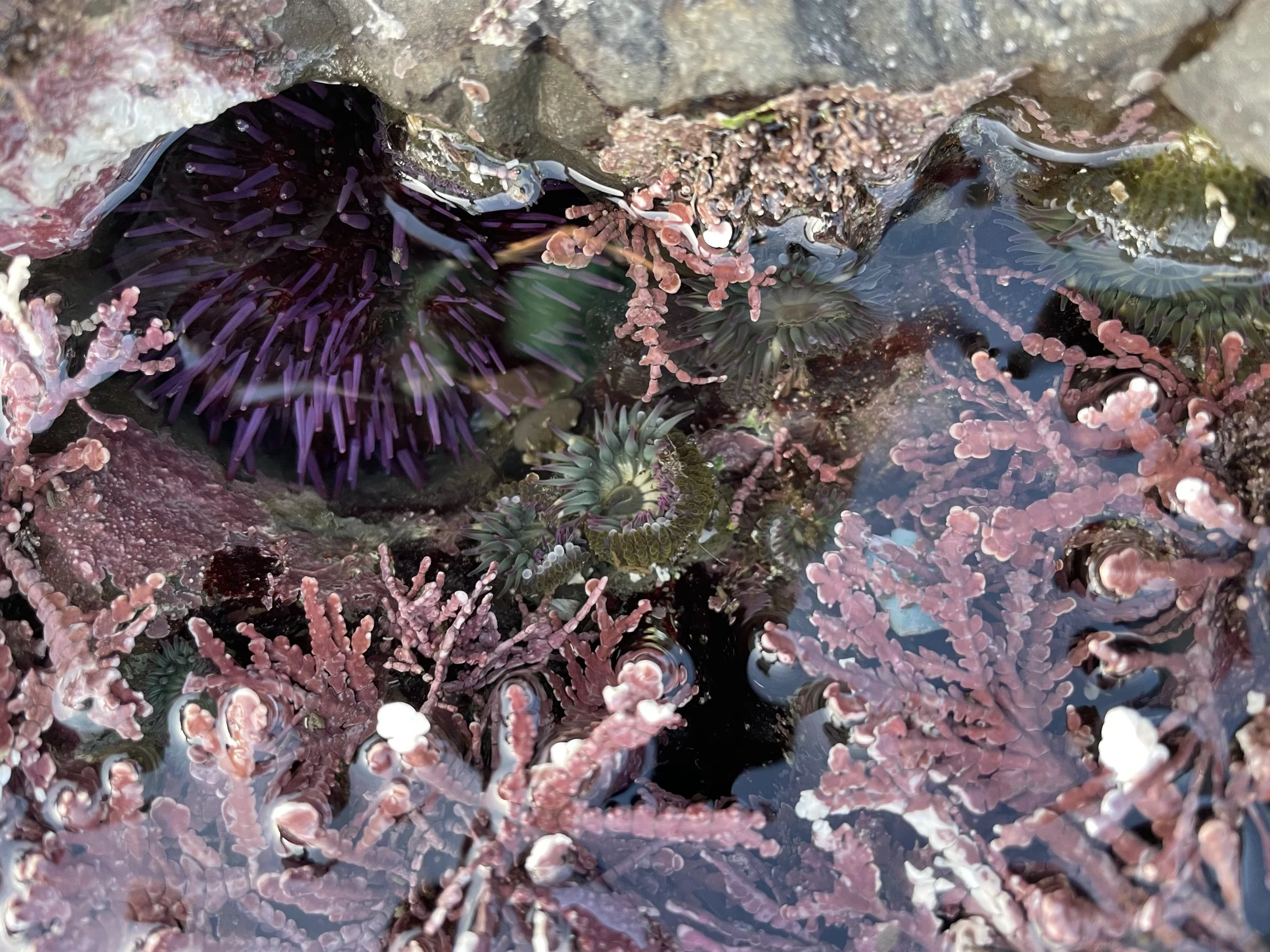Conserving Duxbury Reef:
Petition to Increase Protections
California boasts 124 marine protected areas (MPAs). MPAs exist worldwide and are important because they safeguard habitats, promote biodiversity, help depleted species recover, and help ecosystems become more climate resilient. EAC supports MPAs statewide, including running an MPA community science program locally, Marin MPA Watch.
In early 2023, there was a decadal management review (DMR) of MPAs statewide, including the release of a comprehensive report, which showed that MPAs are working. One of the goals identified from this process, which EAC participated in, was the opportunity for organizations, tribes, or individuals to submit petitions for regulatory changes to MPAs, which could either strengthen or weaken them. Thus, in 2023, we submitted two petitions to update and strengthen regulations at Drakes Estero and Duxbury Reef.
In another 10 years, California’s MPA network will be evaluated again for adaptive management needs.
What does the Duxbury Reef Petition Propose?
The Duxbury Reef Petition proposes redesignating the current Duxbury Reef State Marine Conservation Area as a State Marine Reserve, as well as expanding its boundaries to encompass the full, contiguous reef habitat. This would expand the northern boundary to the Double Point/Stormy Stack Special Closure, and the southern boundary to the most southerly tip of Duxbury Reef exposed at mean lower low water, or to about 37°53’07.9”N, 122°41’45.3”W.
Why does the Petition Propose These Changes?
Duxbury Reef is a current MPA and one of the largest shale reefs in North America. At low tide, the shale reef’s fractures and channels form extensive tidepools filled with a variety of macro algae species, fish like sculpins and monkeyface pricklebacks, crabs, turban snails, octopuses, and other amazing creatures. California mussels and gooseneck barnacles cling to rock surfaces, filtering their food from the water that washes over them with the returning tide. This area’s sandy seafloor and surfgrass beds support perch, flatfish, nudibranchs, crab, and other species. Researchers and community scientists have identified over 200 different species of invertebrates, seaweeds, and marine plants that cling to the reef as the tides change, as well as small fish and seabirds that frequent the reef.
The reef’s amazing and biodiverse habitat extends far beyond the current MPA. The north is part of the Phillip Burton Marine Wilderness and contains relatively pristine habitat that is ecologically connected to that in the existing MPA. Visitation is rare, but increasing. The Double Point/Stormy Stack Special Closure contains crucial seabird nesting areas. Double Point is also home to one of the largest breeding harbor seal colonies in California.
The southern portion of the reef is entirely unprotected but contains many rare and sensitive reef species. It is also an important resting area for marine mammals traveling from the San Francisco Bay to the Farallones and hosts a small but consistent harbor seal colony year-round.
Rocky intertidal habitats are seriously threatened by a variety of local and regional human disturbances (trampling, collecting), disease, pollution, habitat destruction, and invasive species; their intertidal position on our coast makes them particularly susceptible to climate impacts such as sea level rise, ocean acidification, and warming temperatures. Due to these concerns, rocky intertidal habitats were targeted for protection in the Marine Life Protection Act Master Plan. Thus, Duxbury Reef was designated as a State Marine Conservation Area, currently allowing only limited take (recreational fishing from shore, and take of abalone, although the fishery is currently closed).
In the northern area, boats have also been seen violating the Special Closure buffers, disturbing seabirds. The south contains reef habitat and rare species and is entirely unprotected, and marine mammals are disturbed by humans walking there. Additionally, Duxbury Reef experiences high visitation levels and poaching of reef organisms. Allowance of fishing (partial take) confuses many visitors who think all take is allowed when they see shorefishing, poke-pole fishing, or fisherpeople with buckets of bait, or when they read signage or information online that suggests some take is allowed.
Thus, our petition requests that Duxbury Reef be redesignated as a State Marine Reserve (SMR) to more effectively protect this incredibly unique place and its imperiled reef species, which are vulnerable to the combined impacts of disturbance and take, while also requesting that the northern and southern boundaries of Duxbury Reef be extended to include the remaining relatively pristine contiguous reef, which would protect more marine life and ecologically connected habitat types.
We hope that with better protections in place, the species at Duxbury may recover, leading to better tidepooling and educational experiences for all.
What are the Current Regulations at Duxbury Reef, and what Would Change if the Petition were Adopted?
Duxbury Reef is currently a State Marine Conservation Area (SMCA), which is a type of Marine Protected Area (MPA). At this SMCA, all marine life and physical resources are protected with some exceptions:
“It is unlawful to injure, damage, take, or possess any living, geological, or cultural marine resource,” except for the “recreational take of abalone, and finfish from shore only.” Currently, the recreational red abalone fishery is closed until at least April 1st, 2026. A longer closure is expected.
Redesignating Duxbury Reef as a State Marine Reserve (SMR) would mean it becomes a fully protected, “no take” zone. Thus, the current allowances for recreational take of finfish from shore and abalone (when the fishery is open) would not be allowed. However, access for nonconsumptive uses, such as visiting, tidepooling, surfing, boating, kayaking, education, and research, would continue.
Currently, in the proposed northern boundary expansion, rules prohibit boating within 1,000 ft of the Double Pt/Stormy Stack Special Closure. Recreational and commercial motorboats and ALL commercial enterprises are prohibited within ¼ mi from shore from Sculpture Beach to Duxbury Reef due to its designation as a Phillip Burton Marine Wilderness. Due to these existing regulations, expanding the Duxbury Reef MPA north would functionally only restrict recreational take from shore. This does not impact access for non-consumptive uses that are not already affected by the restrictions imposed by the existing Wilderness or Special Closure.
The area in the proposed southern boundary extension is entirely unprotected. The proposed expansion would southern boundary of the current MPA to the most southerly tip of Duxbury Reef exposed at mean lower low water, or to a coordinate point at about 37°53’07.9”N, 122°41’45.3”W. Like the rest of the MPA, this would become a “no take” SMR. This would not impact access for non-consumptive uses, like boating (more examples listed below).
What science supports these changes?
Changing the designation of the Duxbury Reef SMCA to an SMR would likely increase compliance with regulations over time, with consistent messaging, safeguarding this sensitive habitat. Due to limited enforcement, decreasing confusion is critical to the reef’s health. There is a strong body of science that supports that "no-take," full protection marine protected areas, such as State Marine Reserves, are most effective and deliver the greatest protection and benefits for marine ecosystems. Sir David Attenborough’s recent documentary Ocean explains this well. Another study also shows that full protection, no-take MPAs are most effective for public understanding.
Additional scientific backing and letters of support from experts and other scientific agencies are linked below:
EAC Original Petition Submission - November 30, 2023
EAC Supplemental Comments for Duxbury Reef & Submission Index - July 3, 2025
EAC Supplemental Comments - November 26, 2025 and outreach by community member
Learn more
FAQ
Read the original petition, supplementary letters, and additional scientific support:
EAC Original Petition Submission - November 30, 2023
EAC Supplemental Comments for Duxbury Reef & Submission Index - July 3, 2025
EAC Supplemental Comments - November 26, 2025 and outreach by community member
Will Duxbury Reef become a Special Closure?
No. The petition is not asking for Duxbury Reef or any of the extended areas to become Special Closures.
Will this petition restrict fishing in Bolinas Lagoon/all of Bolinas Bay/other areas?
No. The petition only asks for the current Duxbury Reef Marine Protected Area, as well as proposed northern and southern expanded areas, to become a State Marine Reserve. This would cover the area from the Double Point/Stormy Stack Special Closure to the most southerly tip of Duxbury Reef exposed at mean lower low water, or to about 37°53’07.9”N, 122°41’45.3”W.
Notably, the proposed northern extension area is already part of the Phillip Burton Marine Wilderness, which has preexisting restrictions on boating and commercial fishing.
What types of access will be maintained?
Access for all “non-consumptive” uses will be maintained. Non-consumptive uses include things like visitation, tidepooling, kayaking, boating, surfing, education, and research. Additionally, access for dogs will also be maintained. Nearby SMRs, including Estero de Limantour SMR and Point Reyes SMR, allow “all non-consumptive recreational activities” and remain popular places to kayak, bird, hike, and more.
Are other intertidal habitats protected in California?
California’s rocky intertidal habitats are rare, covering around five square miles statewide. Only about 27% of California’s rocky intertidal habitat is protected within MPAs for the well-being of the many species that call it home and for the enjoyment of current and future generations. Many MPAs with similar intertidal habitats are fully protected as State Marine Reserves (SMRs), including the Cabrillo, Point Lobos, Montara, and Point Arena SMRs.
Why can’t there be better enforcement to reduce violations?
For at least 5 years, we have consistently advocated to the California Department of Fish and Wildlife (CDFW) and other local agencies for increased enforcement at Duxbury Reef and MPAs statewide, reporting the high amount of noncompliant take. Others have also presented enforcement requests to Marin County Parks and CDFW wardens. However, this lack of enforcement capacity has not been meaningfully addressed, and we do not expect it to improve soon, especially with state budget restrictions and Duxbury Reef’s remote location. Wardens and rangers are stretched over a large geographical area with many competing priorities and cannot often be present at the reef. We will continue to advocate for better enforcement.
Can better education reduce violations at the reef?
In 2022, we started a docent program at the reef with local residents in response to increased visitation and the high amounts of noncompliant take observed. Our volunteer-led Duxbury Docents program focuses on visitor education and outreach, and is separate from our petition advocacy. While the docent program has been successful in interrupting some violations while providing education, docents frequently report confusion amongst visitors who have seen incomplete online information suggesting some take is allowed, seen signage indicating fishing is allowed, observed fishers with buckets and bait on the reef, or seen others passing through the SMCA from currently unprotected areas (adjacent to the current boundaries) with buckets of fish and other species. It is difficult to provide effective education when visitors see partial take occurring at the same time. We believe education at the reef would benefit from the simple and consistent messaging of an SMR. Additionally, all docents are volunteers who cannot be on the reef every day. Docents are also not law enforcement, and while they can educate visitors, they cannot enforce regulations.
Can we just add better signage at Duxbury Reef?
EAC and residents continue to advocate for better signage. EAC designed and has posted temporary signs that more clearly illustrate the “partial take” rules at Duxbury Reef. These are posted when docents are on the reef. However, these signs have not been enough to deter collection, and EAC staff have personally witnessed people ignoring our temporary signs and continuing to collect. One study evaluating the effectiveness of MPA signage in California found that less than 5% of visitors to MPAs read signs upon arrival. While we continue to advocate for better signage, we believe the clear and simple messaging of an SMR would benefit not only signage but all the other components that contribute to visitor understanding.
When can red abalone be harvested again?
Currently, the recreational red abalone fishery is closed, and abalone cannot be harvested. This is due to their declining numbers. The current closure will last until April 1st, 2026. In August 2025, CDFW staff recommended the red abalone closure continue for 10 years until April 1st, 2036, due to a lack of statewide recovery of the population. At the August Fish and Game Commission meeting, a notice of intent to update the regulations was approved unanimously. It is highly unlikely the red abalone fishery will open anytime soon.
What is a “petition” in the context of the Fish & Game Commission?
In this context, our Duxbury petition is a formal petition submission to the Fish and Game Commission for a rulemaking or regulation change. This is dissimilar to a petition where signatures are gathered. However, in support of our petition, we have gathered support, including numerous letters of support.
What is the timeline for the MPA petition process?
Learn more here. At the August Fish & Game Commission meeting, a framework was approved for the evaluation of the bin 2 petitions by the California Department of Fish and Wildlife staff. Bin 2 petitions, which include Duxbury Reef, are more complex and require additional policy guidance and information before evaluation. The substance of the staff recommendations and decision-making likely won’t take place on Bin 2 (including the Duxbury Reef petition) until 2026.
I have questions/concerns/comments, or I want to support the petition. Who do I contact?












